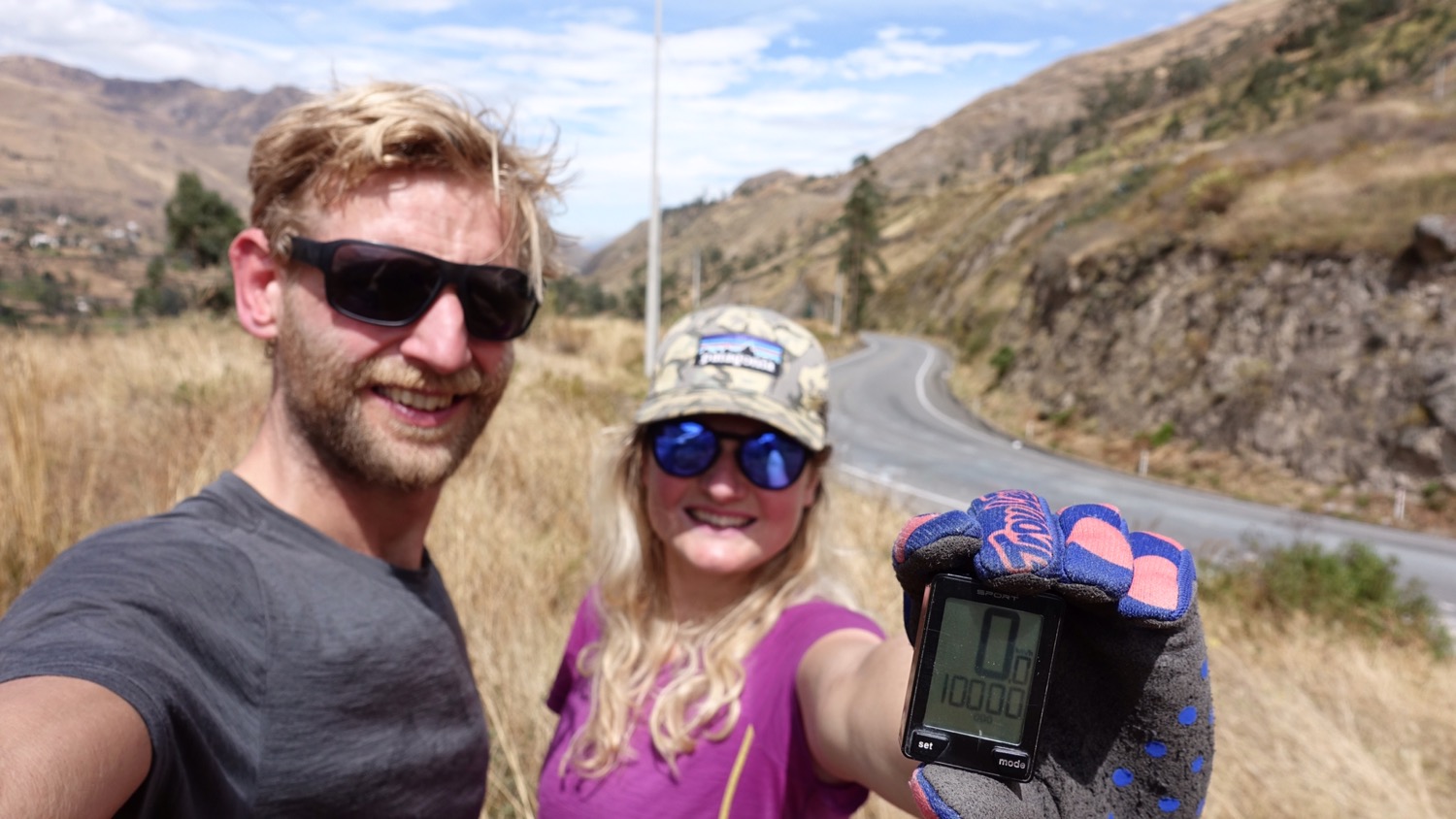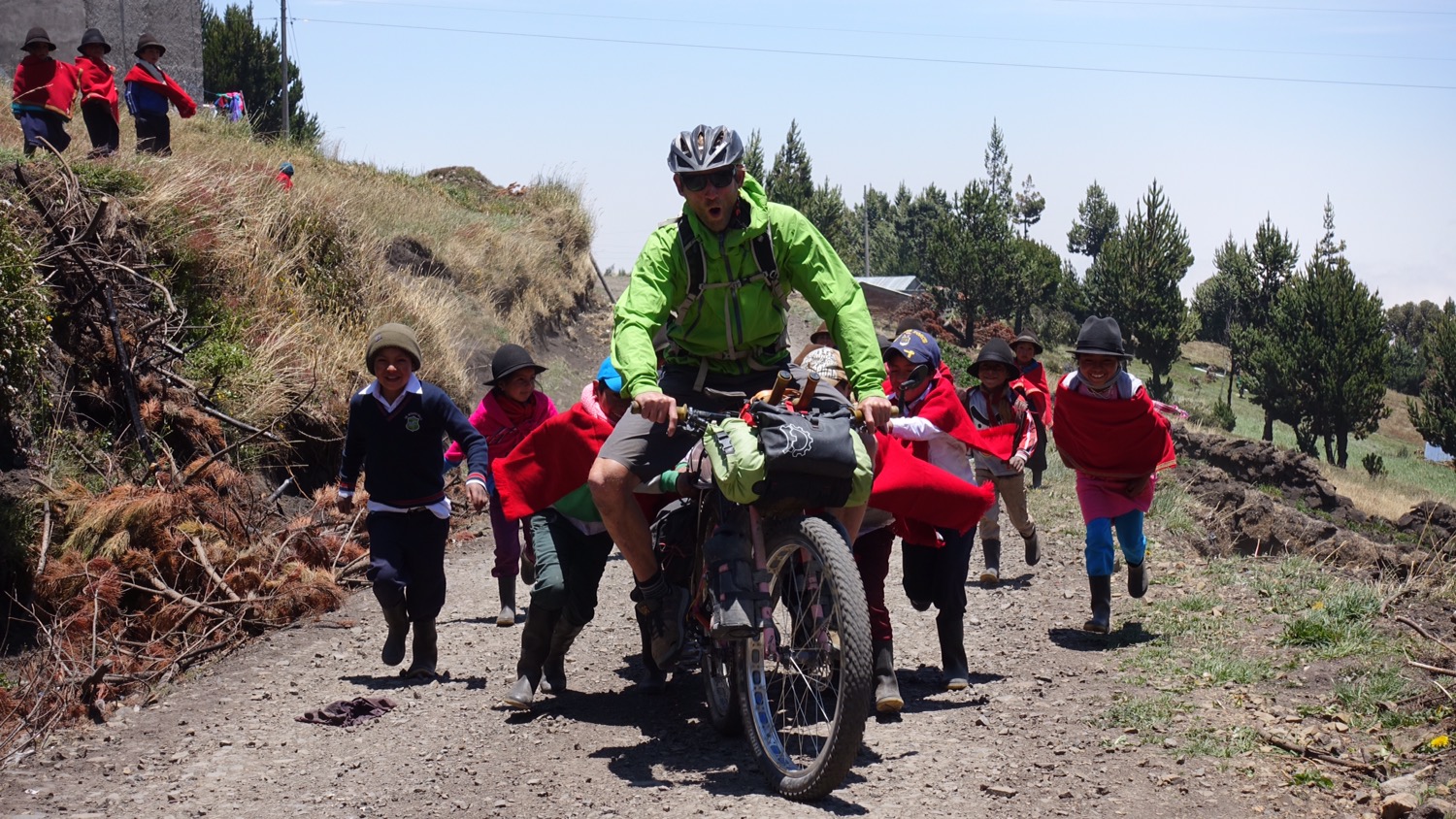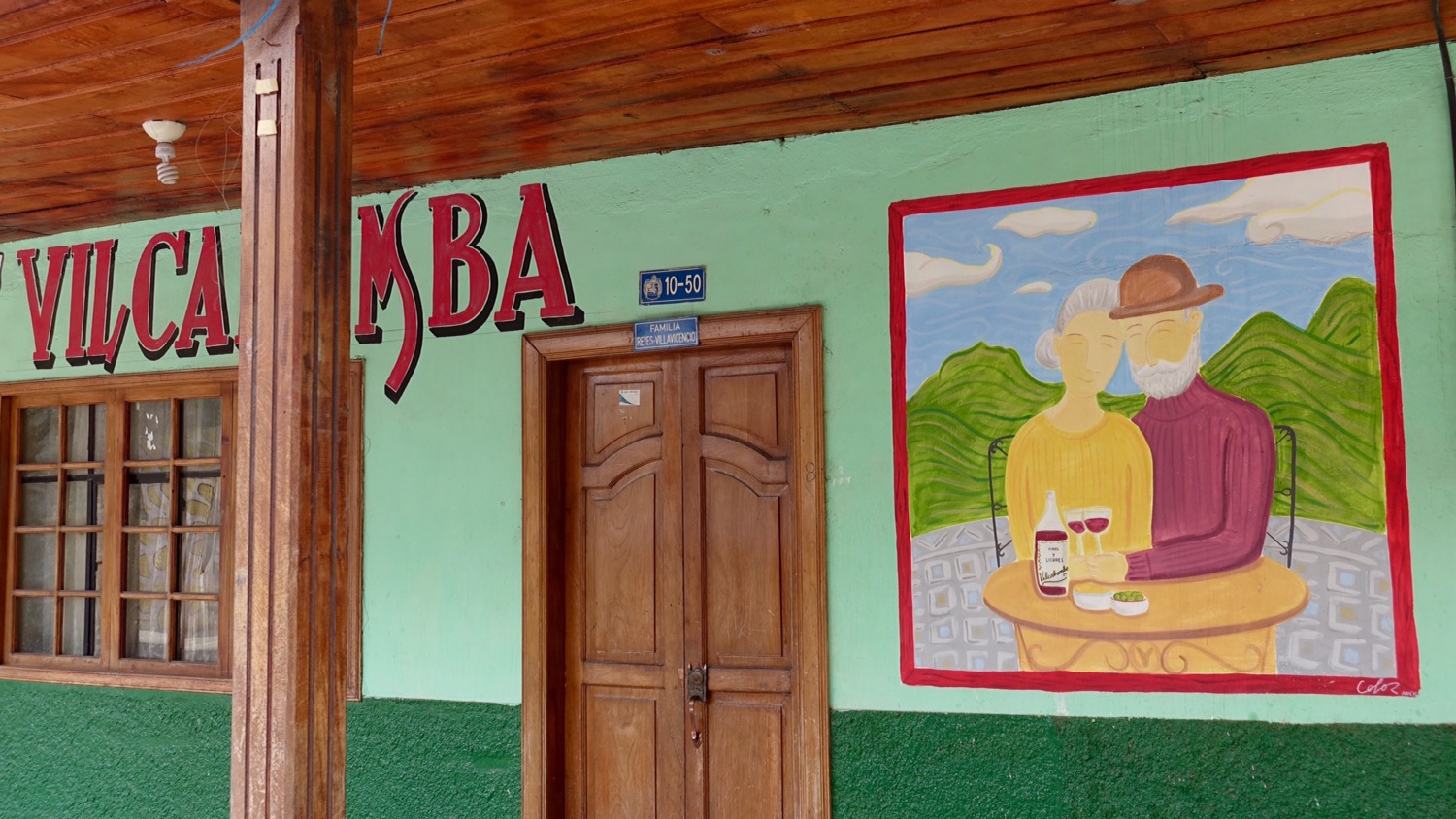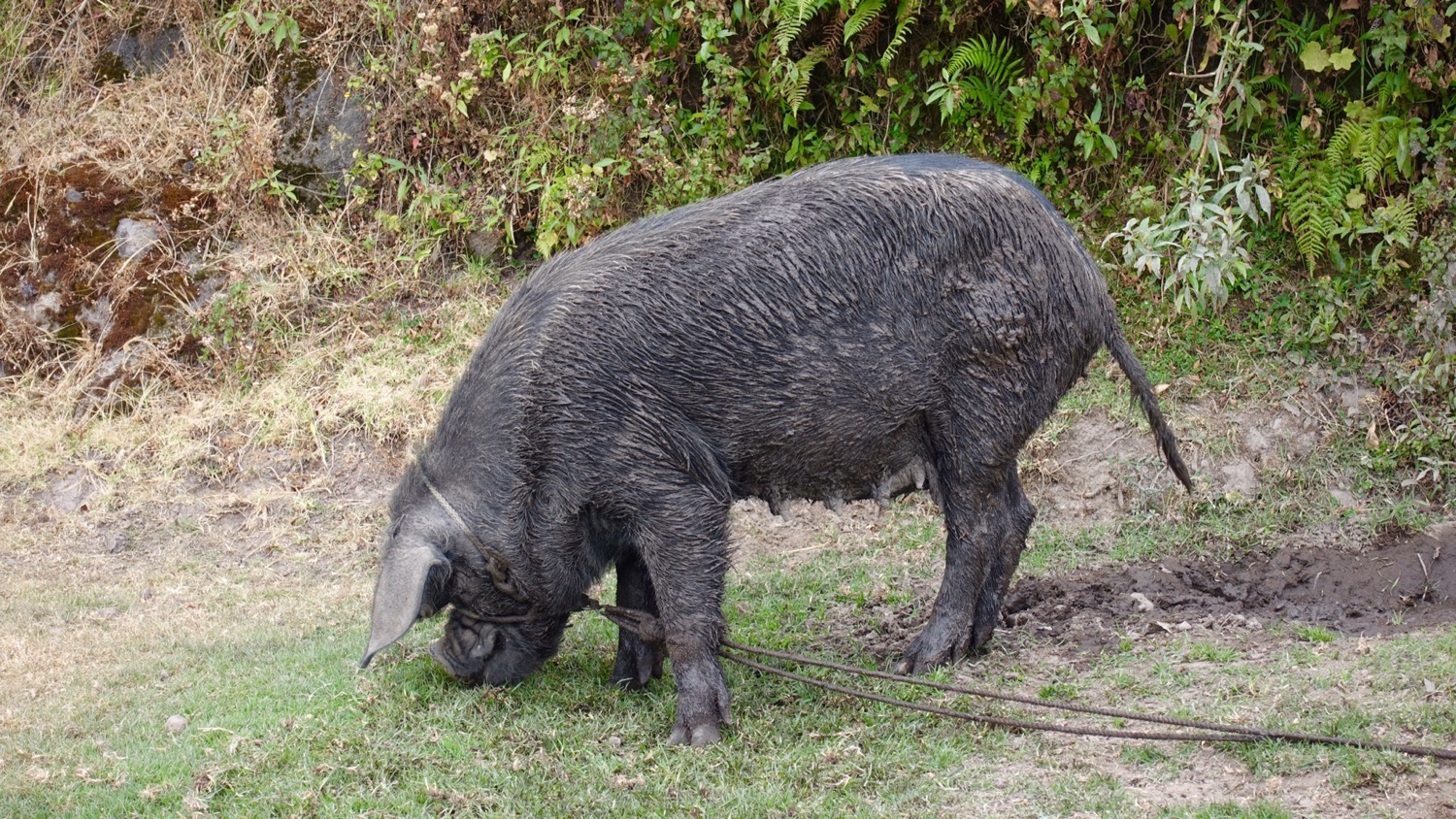We enter a market, someone laughs behind me, I turn to see 3 elderly ladies with gold butterfly patterns on their teeth. They think I'm the funniest thing they've seen today and giggle and laugh and one of them says "Miiiiister" after me.
We stop at a roadside restaurant, immediately people talk to us. Who are you, where are you from, where are you going, beautiful bikes, this is my mom and my sister, what do you want, sit here, are you from the US?
This is our immediate impression of Ecuador as we cycle across the border from Peru. That, and then an elderly lady who stops us on the dirt road far out in the middle of nowhere. She asks about our ride and gives us two bananas to continue cycling on.
We find that people here in Ecuador have a warm twinkle in their eye, are much more open and alive and free than we have seen in Bolivia and Peru. And it's lovely. It's liberating when people laugh at us. It makes it much easier to have a chat. There is not the same filter of politeness as in recent months. We feel more equal with people.
And it gave us the best start to cycling in Ecuador.
Nature changes the scene. From the high, barren and cold mountains of Peru, we now come further down, and the mountains of southern Ecuador are green, lush, round. The houses change character, we see beautiful handmade, burnt bricks on the roofs of the brick houses. We can see that there is a little more money to be made. The rate is in dollars and things are a little bit more expensive. On the negative side, the dogs have become slightly more biting. They are still only out to guard the house they live in, and take every chance they can to make the life of a poor cyclist. Our defense is to look at the dog, notice if it really wants to eat us, and if not, to continue undaunted. There have not yet been any dogs that wanted to eat us.
We had heard that Ecuador's roads are steep. And just to emphasize the point, we were only 50m after the border before we had to get off the bikes and pull up the road. It got better with time, but sometimes we have to get lost on the small dirt roads out in the country and drag the heavy bikes. On average, we have driven just over 1,300 altitude meters per day. And on average the bike probably weighed 40kg. So the rest days have been welcome.
The first rest day we had was in a small town, Vilcabamba. We had heard that it was a real 'Gringo town'. We thought it meant a lot of backpackers, so we could exchange experiences and tips for our further trip. However, it turned out to be a completely different type of 'Gringos'. When we went for a walk in the city, we started to wonder about the lot of white hair we saw in the street scene. Just as we saw a distinct change in food culture, towards vegetarian food. And a few yoga centers. Only after talking to an elderly gentleman in a small cafe did it dawn on us that Vilcabamba is the paradise of retired Americans. The man told us that he had read two different studies, both of which pointed to Vilcabamba as one of the best places in the world to enjoy retirement. Partly because of the climate. Partly because of the cosmic energies that were found here. And precisely that with the cosmic energies clearly attracted a special part of the retired Americans. During the day, we spoke to several of the pensioners, who all had stories to tell about why they had moved here, what all the white quartz stones in the area did for them, about the effect the food has on them. All people who seemed to be searching for a better place in life. All of them lived a parallel existence with the native part of the city's population, without knowing Spanish.
But interesting to experience.
From Vilcabamba starts the Trans Ecuador Mountain Bike Route: The Dirt road version. (TEMBER). That means another one of the bikepacking tracks that we wanted to ride on our trip. The track consists mostly of dirt roads that wind out into the countryside, at a suitable distance from the fairly busy Pan American Highway.
The trail is relatively new, and we soon found out that we had to be careful about using the map frequently. The route is designed to run from north to south. We drove in reverse. It sometimes presented a bit of a challenge, because it is certainly not certain that a fun, steep, technical descent is as festive as pulling your heavy bike up when you come the other way. But it also gave us opportunities to come up with some shortcuts ourselves, alternative fun descents, but also more passable ascents. All in all, with a watchful eye on the landscape and the map, it was a fantastic route we set out on.
We had to get used to the capricious weather. Almost every day it was cloudy. And virtually all the high passes we drove over punctured the clouds so that the rain poured down on us. But pretty much every day, we woke up to sunshine and warm weather. It became a dress rehearsal of rank. All day it's putting on clothes, taking off clothes, putting on more clothes, etc etc. But it never took away the joy from cycling. And we always knew we would be dry again soon.
The food culture changed a little from Peru to Ecuador. Not much, but in the small details a little happened. There is definitely a greater representation of chicken feet in the soup, here in Ecuador. However, there is still the same amount of rice and potatoes on the plate when we talk about the main course. One of the great specialties, especially in the south, is a form of whole roasted suckling pig. The way we discovered it was pretty straightforward. We cycle out along the country road, there is a classic food stand on the side of the road, a whole pig is tied to a post, with flambéed skin. Yes – it can be done so simply and visually if what you are selling is piglets. Later we saw more and more piglets, usually less macabrely hung up. But always with a piece of flambéed, black skin. And of course it wasn't long before we had planted ourselves at a long table, on a Saturday morning, to taste the animal. And what a great dish. Often when we eat, we look for the small stalls or markets where the cooks are. These are ladies who have been standing there for many years, preparing traditional, local food. And it can be tasted. They know what they are doing. And when you give them an appreciative comment for the food, there is often only a nod of agreement left. They know what it tastes like.
And then the reader's curiosity should not be lost on how they flambé the skin into a very thin form of pork belly: With a large flamethrower, of course.
In the more exotic department, we have discovered and eaten so many fruits here that we didn't even know existed. Chirrimoya – a green, hard, knobby skin, about the size of an apple, with completely white, sweet flesh. A milkshake with a guy like that, and then blueberries, you're sent straight to heaven. Guanabana - which I can hardly explain what it looks like, but if you get it as a juice, it is green and very nuanced in its taste. Tree tomatoes – grow on the trees (surprise), taste a lot like tomatoes, but sweeter and more nuanced, and are also primarily used for juice.
In Denmark, we import bananas from Ecuador, but what we didn't know was that here they have 5 different types of bananas. Some just for cooking, and at the other end of the spectrum, tiny sweet bananas.
It is a huge part of the experience for us, tasting the many different types of dishes, fruit and vegetables they grow here. In general, you can say that they don't eat very much meat. Their diet consists almost entirely of the things they grow locally. Only in the bigger cities, you can go to a 'tourist restaurant' and get food like we know at home. But you have to stay away from that, because that is not what they are good at. In addition, the local food is truly sustainable. Both in its way of being produced, as they have to a much greater extent small farms that work together in collectives. On the small farms, they usually work more traditionally (we would say old-fashioned), which simply means that the pollution is very little. And since the items are produced locally, they do not have to be transported as far, and again it pollutes less. One last thing that we appreciate by eating the local dishes is that we support the small communities we travel through, rather than buying the things in the supermarkets that they import from other countries. These are principles which can be complicated to follow in Denmark, but which are much easier here, because the entire food production is not drowned in multinational profit thinking yet.
Ecuador actually means 'Equator'. After completing the 10,000 km since Ushuaia, we also managed to cross the equator. However, we only discovered it a few days later. We think they could have painted a dotted line across the country so forgetful long-distance cyclists had an honest chance to celebrate such a big event. But that means we are now back in the northern hemisphere. We look forward to seeing the Chariot in the night sky again soon.
Another curiosity we have witnessed is the world's highest mountain. So measured from the center of the earth. Chimborazo is a 6,263 m high volcano that towers beautifully over Ecuador. But because of its location so close to the equator, and because the earth is thick around the belly, it is therefore higher than Mt. Everest if measured from the core of the earth.
In South America we have discovered that there has been a sport in being able to classify any mountain, city, river, crater, whatever, as the best in the world. If only you measure it in a certain way, or perspective it a little differently than usual.
Another really beautiful volcano in Ecuador is Cotopaxi. It has an almost perfect volcanic shape. It looks like a child would draw a volcano. Completely conical, with a round hole at the top where smoke comes out. There is currently no smoke, but in the spring of 2006 it rained ash in the capital Quito, 50 km from the volcano. The volcano has erupted about 50 times in the past 300 years and is still active. As recently as 2016, the volcano has been active, and the government of Ecuador has earmarked 500 million dollars for the aftermath of a possible, imminent, eruption.
It was at the foot of this beautiful volcano that hides in the clouds that one morning we were packing up our tent when 4 other bikepackers rolled into our camp. The recognition was quick, albeit unidirectional. The four boys were Michael and Thomas Dammer, Cass Gilbert and Jay Ritchey. We knew that Jay had been filming Cass and a few others in the Peruvian mountains for the past few weeks. Actually on the Peru Divide Trail, which we had also just cycled. We had written to Cass about their schedule to see if we could meet them along the way, but it didn't add up. And now they were here in Ecuador, cycling right into the middle of our camp.
The Dammer brothers are Ecuadorians, and have helped Cass Gilbert design and fine-tune the TEMBR, which is exactly the route we follow in Ecuador. Cass is not only the greatest writer in the bikepacking field, but has also created countless routes. He has especially cast his love on South America, where the majority of his work is found. He has dedicated his life to bikepacking, and to writing about it, and we have read a large number of his articles, followed his routes, and learned to understand his thinking around route planning and the many practical aspects of running a longer bikepacking trip.
It was a pleasant couple of hours at the foot of Cotopaxi, with robber stories criss-crossing, pictures were snapped left and right, and an agreement that we could spend a few days together, on the farm of the Dammer brothers, close to Quito.
When we met them a few days later, Cass wanted to write an article about us and about our hand built Ari bikes, which he really liked.
It turned into a Rider-and-rich article on Bikepacking.com that we are really proud of. You can read the article here.
We also had the opportunity to offer something the other way, as we had made quite a few notes on suggestions for improvements to TEMBR. We spent some time with Cass going over the route and have since emailed about the final adjustments. It is thus also with completely hidden pride that we can say that we have made a tiny contribution to the gigantic route TEMBR is.
Already at home in Denmark, before we left, we had read about a special area on the route. In northernmost Ecuador, on the border with Columbia, there are some very special, rare plants called Frailejón. We had made that one of our highlights in Ecuador, to see the plants. They grow in an area which is almost constantly under cloud, so it was a wet and gray pleasure to head up the mountain to the nature park. The Frailejón plant has huge petals that suck the moisture out of the air and store the water inside the plant and the roots. It thus does not absorb the water through the soil, as other plants do. Its large petals look almost mushroom-like, with a strange, mysterious cobweb-like pattern over them. The petals are easily 50cm long. And just as we were there, little yellow sunflower flowers bloomed on the petals. The petals wither every year, and when new ones grow out, the planet grows by about 1cm. Some of the plants we saw were 3m high, so they can be hundreds of years old.
It was an absolutely magical sight to stand in the middle of a hilltop and see millions upon millions of these very special plants surrounding us, on all the hillsides as far as we could see.
It was a very special experience for us, and a really nice end to Ecuador.
Of all the experiences we have had in this fantastic country, of which only a fraction made it here, there is one thing that stands out most clearly for us. And it's the amazing people. We have met so many welcoming people. Warm and loving. Giving and curious. And even if we never quite found out why the old ladies laugh at us, it doesn't matter, because they do it with love and kindness in their eyes. And the non-verbal message that lies in this, being able to laugh while looking another person deep in the eyes, it is something that touches one's heart and soul in a way that we can hopefully take with us and never forget.
Ecuador - see you again.




























